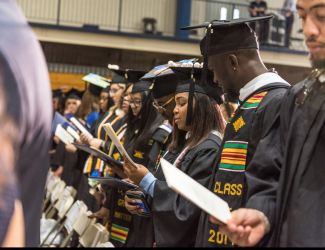In the ever-changing world of university finances, where every increase in tuition sends concern through the student body, one aspect remains constant: the role of journalism in uncovering the truth behind these economic decisions.
In the past 65 years of the Loquitur, there has been a lot of coverage of this issue. Two reporters who wrote articles about tuition prices were Brendan Noone and Chris Pesotski.
Noone, who wrote “Tuition increase raises questions” in 1993, reminisced about the process involved in reporting on rising tuition numbers. “I remember interviewing a couple folks at admissions. I think we got the news that it was raising from $9,020 to $9,742 in the mail… And then they also because of the backlash had to talk about it a little more publicly as to why they were doing it.”
In the original article, Noone wrote “According to a letter circulated by President Antoinette Iadarola this Easter break… Students will experience an increase in tuition from $9,020 to $9,742, raising the tuition for residents to $16,532.”
Noone said of community sentiment at the time, “It was more about ‘what are we doing to build up the school?’ … We need more tools and less toys.” Negative coverage often resulted in pushback from those at the top. “When we would write something that wasn’t the company line, it was very possible that you wouldn’t get the access to administration that you potentially needed.” Yet, despite these obstacles, the team remained steadfast in their commitment to informing the community.
The reporting process around why Cabrini needed more tuition money, Noone said, began with a central question: “You have to follow the money right? Like, where did that money go? And what was it used for? It’s the seeds that were planted, it’s the money trail.”
A different but similar view
Chris Pesotski, the news editor in 1991, also reported on the rise in tuition. Eventually, that experience led him to work in college financial aid offices later in life. “Traditionally,” he said, “we would begin hearing rumors about what the number was going to be… normally it was fairly late in spring that students would be informed about what the increase would be.”
In an article in 1991, Kimberly Marshall, who wrote in the news section, wrote the article “Trustees approve record 15 percent tuition and board increase for ’91- ‘92,” which says “[Former president Sr. Eileen Currie] said that the reasons for the increase are the downturn in the traditional-age-college student population, and unclear levels of state and federal funding… Cabrini will cost $8,350. Room and board is $5,515.”
Pesotski also talked about the challenges the newsroom faced. “We would put a request to the CFO (chief financial officer), who at the time was John Barclay, to ask him for an interview a week before, because we knew they weren’t going to tell us anything before the board approved it. So, right after that, we would be granted an interview where we would discuss what the numbers actually were.”
Financial insights
Since his time on the Loquitur, Pesotski has worked in financial aid admissions, associate vice president of enrollment at University of the Arts, director of financial aid at Rowan College at Burlington County, and spent nine years as a consultant working with colleges and universities on pricing.
The crux of this issue lies in confronting the realities of financial instability. “There is no way for most schools to survive without raising tuition on a regular basis,” Pesotski said. In an era where the value of a bachelor’s degree is scrutinized, colleges grapple with the reality that they need to deliver quality education while balancing the books.
Reminiscing on the past
With tuition increasing at an alarming rate even now, going from $8,350 in 1991 to $34,665 in 2023, there is no shortage of questions to be asked about tuition. In 1983, Paul Moser wrote the article titled “Administration justifies 9.5 percent tuition increase,” where he reports that then-President Antoinette Iadarola raised the tuition to $13,900, saying, “This comes at a time that U.S. inflation is about 3 percent, and many colleges are trying to hold a 2.5 to 4 percent rise.”
The Loquitur has been running for 65 years, and in that time the paper has covered a number of controversies here at the school. Tuition has been an ever-changing problem all across the nation, and the Loquitur has always been sure that students understand what this means for them, as the students are the most effected.
Pesotski recalled about his time on the Loquitur, “It was a lifestyle, it was everything you did, it was like being on a sports team.” Noone added, “You have a big responsibility at 65 years… people put a lot of energy into this over all those 65 years.”




